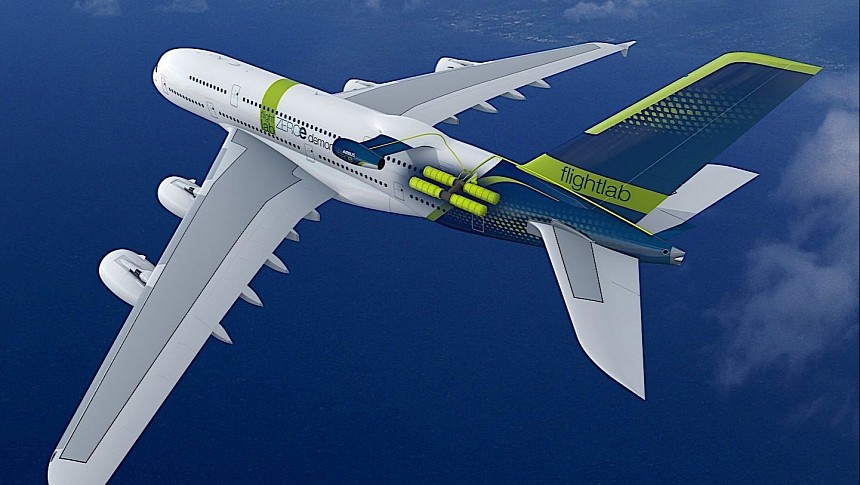It seems that everyone in the aerospace industry is working hard to come up with alternative, greener solutions to power commercial aircraft. Whether we're talking about the mighty Sustainable Aviation Fuel (SAF) or wackier hardware like the NASA HyTEC, one of these ideas is bound to stick.
European aerospace giant Airbus is betting the idea that will stick is the use of hydrogen for fuel. So confident is the company that this is the future that three years ago it started an impressive study into the matter together with engine maker Safran and space company ArianeGroup.
The project was called HyPERION, and it was "designed to evaluate hydrogen propulsion solutions for commercial aviation." The driving idea behind it was not necessarily to come up with a suitable solution to make hydrogen the aviation fuel of the future, but to find what the best propulsion solutions would be.
And find they did, as the best tech to make airplanes capable of safely running on hydrogen seems to be the one already in use in space exploration, which uses liquid hydrogen on a large scale.
It took the parties involved a lot of time to reach a conclusion, because every aspect of hydrogen use was studied, from how the fuel leaves the tanks to how ignited gases are evacuated.
Teams of engineers looked at how hydrogen combusts, what metals need to be used to be compatible with fuel, and how the hydrogen can be stored as a liquid and then conditioned for optimal temperature and pressure in the engines.
Back in May, the HyPERION project ended with a proof-of-concept test performed by ArianeGroup.
The tech being tested comprised a hydrogen conditioning system meant to supply an aeronautical gas turbine, and was made using mostly hardware designed for space exploration: the electric pump, gas generator, and exchangers, among others.
The test was a success, were told, and it opens the doors to an "alternative to fossil fuel for commercial aviation," one that could possibly be in use as soon as 2035.
The parties involved are confident that, aside from proving that space tech is more than suited for use in commercial aviation, advancements made in other fields with this project will help attain that goal.
We're told, without being provided with any details, that significant advances were made "in the definition of hydrogen propulsion systems for commercial aircraft." HyPERION also proved hydrogen can be safe when used in this manner and, most importantly various technologies needed to made this dream a reality have been identified.
Many of them still need to be developed, Airbus says, but at least now the people involved in this research now know what they are.
Neither of the parties involved said anything about what comes next, but ArianeGroup has long expressed interest in applying space tech in commercial aviation. All that's left is for us to wait and see whether the airplanes of the not-so-distant future will fly thanks to the good-old rocket science.
The project was called HyPERION, and it was "designed to evaluate hydrogen propulsion solutions for commercial aviation." The driving idea behind it was not necessarily to come up with a suitable solution to make hydrogen the aviation fuel of the future, but to find what the best propulsion solutions would be.
And find they did, as the best tech to make airplanes capable of safely running on hydrogen seems to be the one already in use in space exploration, which uses liquid hydrogen on a large scale.
It took the parties involved a lot of time to reach a conclusion, because every aspect of hydrogen use was studied, from how the fuel leaves the tanks to how ignited gases are evacuated.
Teams of engineers looked at how hydrogen combusts, what metals need to be used to be compatible with fuel, and how the hydrogen can be stored as a liquid and then conditioned for optimal temperature and pressure in the engines.
Back in May, the HyPERION project ended with a proof-of-concept test performed by ArianeGroup.
The tech being tested comprised a hydrogen conditioning system meant to supply an aeronautical gas turbine, and was made using mostly hardware designed for space exploration: the electric pump, gas generator, and exchangers, among others.
The test was a success, were told, and it opens the doors to an "alternative to fossil fuel for commercial aviation," one that could possibly be in use as soon as 2035.
The parties involved are confident that, aside from proving that space tech is more than suited for use in commercial aviation, advancements made in other fields with this project will help attain that goal.
We're told, without being provided with any details, that significant advances were made "in the definition of hydrogen propulsion systems for commercial aircraft." HyPERION also proved hydrogen can be safe when used in this manner and, most importantly various technologies needed to made this dream a reality have been identified.
Many of them still need to be developed, Airbus says, but at least now the people involved in this research now know what they are.
Neither of the parties involved said anything about what comes next, but ArianeGroup has long expressed interest in applying space tech in commercial aviation. All that's left is for us to wait and see whether the airplanes of the not-so-distant future will fly thanks to the good-old rocket science.









